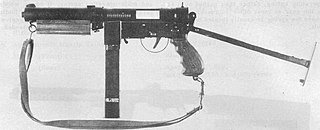
A submachine gun (SMG) is a magazine-fed automatic carbine designed to fire handgun cartridges. The term "submachine gun" was coined by John T. Thompson, the inventor of the Thompson submachine gun, to describe its design concept as an automatic firearm with notably less firepower than a machine gun. As a machine gun must fire rifle cartridges to be classified as such, submachine guns are not considered machine guns.

The MP 40 is a submachine gun chambered for the 9×19mm Parabellum cartridge. It was developed in Nazi Germany and used extensively by the Axis powers during World War II.

The STEN is a British submachine gun chambered in 9×19mm which was used extensively by British and Commonwealth forces throughout World War II and during the Korean War. The Sten paired a simple design with a low production cost, facilitating mass production to meet the demand for submachine guns.

The FG 42 is a selective-fire 7.92×57mm Mauser automatic rifle produced in Nazi Germany during World War II. The weapon was developed specifically for the use of the Fallschirmjäger airborne infantry in 1942 and was used in very limited numbers until the end of the war.
The Suomi KP/-31 is a Finnish submachine gun that was mainly used during World War II. It is a descendant of the M-22 prototype and the KP/-26 production model, which was revealed to the public in 1925. It entered service in Finland in 1931, and remained in use until the 1980s.

The MP 18 is a German submachine gun designed and manufactured by Bergmann Waffenfabrik. Introduced into service in 1918 by the German Army during World War I, the MP 18 was intended for use by the Sturmtruppen, assault groups specialized in trench combat, as a short-range offensive weapon that would provide individual soldiers with increased firepower over a pistol.

Hugo Schmeisser was a German developer of 20th century infantry weapons.
The Beretta Model 38 was an Italian submachine gun introduced in 1938 and used by the Royal Italian Army during World War II. It was first issued to Italian police units stationed in Italy's African colonies. The Italian army was impressed by the gun's performance and decided to adopt a version to be used by the army's elite formations and military police, but requested a modified variant which had no bayonet and a different muzzle brake. This variant was widely used by the Royal Italian Army on all theatres of World War II Italy was involved in. The guns were also used by the German, Romanian and Argentine militaries of the era.

The Błyskawica was a submachine gun produced by the Armia Krajowa, or Home Army, a Polish resistance movement fighting the Germans in occupied Poland. Together with a Polish version of the Sten sub-machine gun, with which it shares some design elements, it was the only weapon mass-produced covertly in occupied Europe during World War II.
The 9×19mm MP 3008 was a German last ditch submachine gun manufactured towards the end of World War II in early 1945.

The PPSh-41 is a selective-fire, open-bolt, blowback submachine gun that fires the 7.62×25mm Tokarev round. It was designed by Georgy Shpagin of the Soviet Union to be a cheaper and simplified alternative to the PPD-40.

The United Defense M42, sometimes known as the Marlin for the company that did the actual manufacturing, was an American submachine gun used during World War II. It was produced from 1942 to 1943 by United Defense Supply Corp. for possible issue as a replacement for the Thompson submachine gun and was used by agents of the Office of Strategic Services (OSS). However, its usage was limited, and the Thompson continued to see service until the end of the war, alongside the M3 submachine gun, which was designed around the same time as the M42.

The Welgun was a prototype submachine gun developed by the British irregular warfare organisation, the Special Operations Executive. Although it performed well in tests, it was never adopted, and was produced in small numbers only.

The Erfurter Maschinenfabrik (ERMA) was a German weapons manufacturer founded in 1922 by Berthold Geipel. Prior to and during World War II it manufactured many firearms, including the Karabiner 98k, the MP40 and other submachine guns.

The M3 is an American .45-caliber submachine gun adopted by the U.S. Army on 12 December 1942, as the United States Submachine Gun, Cal. .45, M3. The M3 was chambered for the same .45 ACP round fired by the Thompson submachine gun, but was cheaper to mass produce and lighter, at the expense of accuracy. The M3 was commonly referred to as the "Grease Gun" or simply "the Greaser," owing to its visual similarity to the mechanic's tool.

The German submachine gun EMP also known as MPE was produced by the Erma factory, and was based on designs acquired from Heinrich Vollmer. The gun was produced from 1931 to 1938 in roughly 10,000 exemplars and exported to Spain, Mexico, China and Yugoslavia, but also used domestically by the SS. It was produced under license in Spain by the arsenal of A Coruña under the designation M41/44.

The MP 36 was a submachine gun designed in 1936 and produced by Nazi Germany during World War II. It was a select-fire 9×19mm Parabellum submachine gun with a wooden body and a steel folding stock.

The PPS is a family of Soviet submachine guns chambered in 7.62×25mm Tokarev, developed by Alexei Sudayev as a low-cost personal defense weapon for reconnaissance units, vehicle crews and support service personnel.

The Lmg.-Pistole Mod. 1941/44 – also known as Furrer MP 41/44, MP41/44 and LMG-Pistole – was the first submachine gun manufactured in Switzerland for the Swiss Army. The weapon used a complicated toggle-operated short recoil mechanism for its operation and it corresponds to that of the Furrer M25, which is why it is also called Lmg.-Pistole.
















